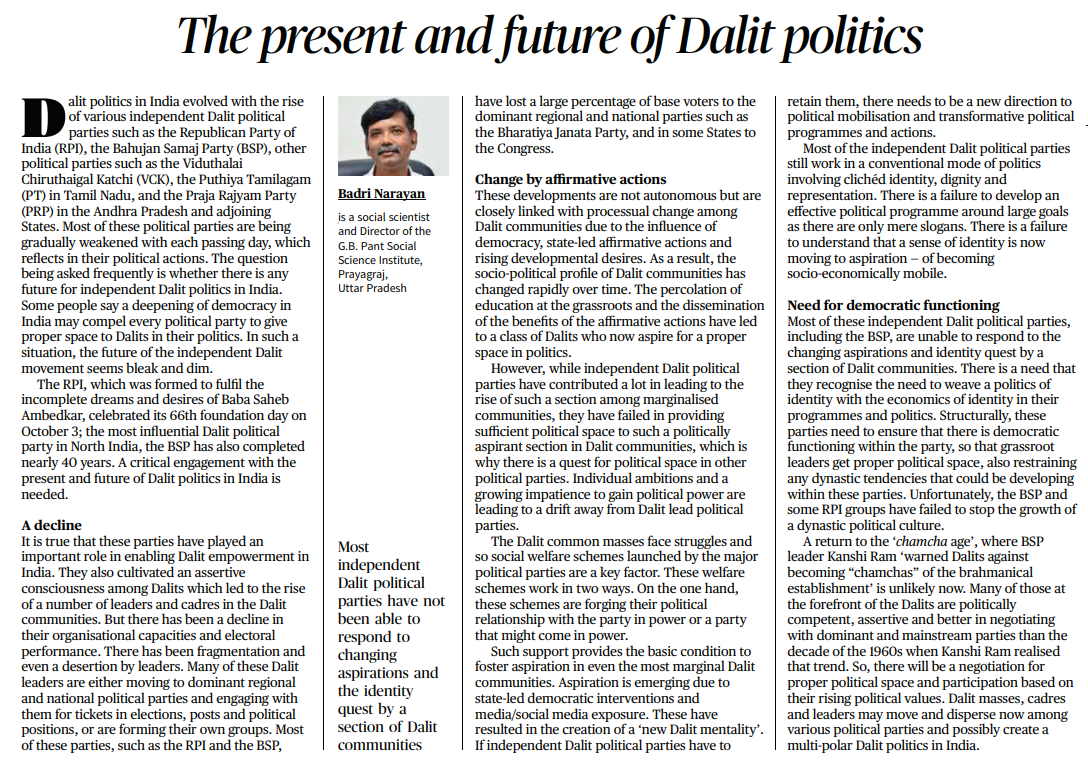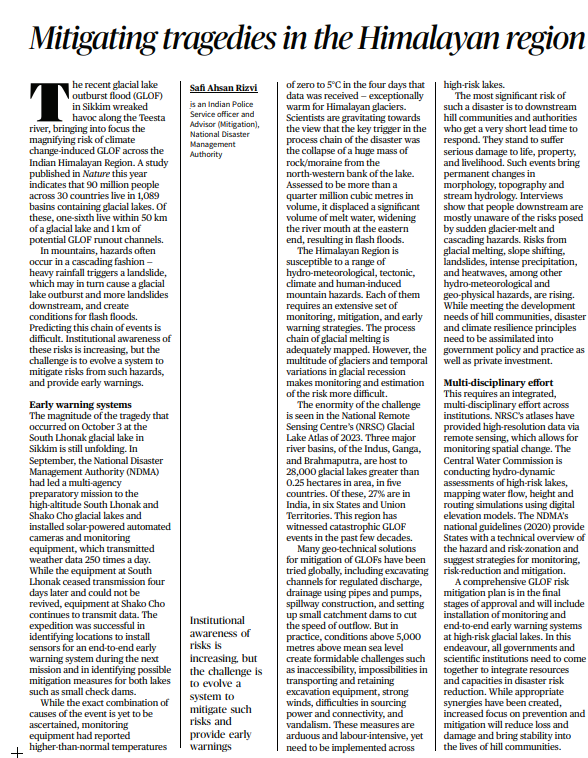Dalit Politics in India: Challenges and Prospects
Introduction:
- Dalit politics in India has witnessed the emergence of several independent Dalit political parties, such as the Republican Party of India (RPI), the Bahujan Samaj Party (BSP), and others like the Viduthalai Chiruthaigal Katchi (VCK), Puthiya Tamilagam (PT), and Praja Rajyam Party (PRP).
- However, these parties are facing declining organizational strength and electoral performance, raising questions about the future of independent Dalit politics in India.
The Decline of Independent Dalit Parties:
- While these parties have played a vital role in empowering Dalits and fostering assertive consciousness, there has been a decline in their capacity and influence.
- Many Dalit leaders are now either aligning with dominant national and regional parties or forming their own groups, resulting in a loss of base voters for parties like RPI and BSP.
Change Through Affirmative Actions:
- These changes are linked to transformations among Dalit communities due to democracy, state-led affirmative actions, and rising developmental aspirations.
- Education and affirmative action benefits have created a class of Dalits aspiring for greater political representation.
- Independent Dalit parties, however, have struggled to provide this political space, leading to a quest for inclusion in other parties.
Social Welfare Schemes and Aspiration:
- Social welfare schemes by major political parties have built a political relationship with marginalized Dalit communities, nurturing aspirations.
- The state-led democratic interventions and media exposure have given rise to a ‘new Dalit mentality.’ Independent Dalit parties need to adapt to this changing landscape.
The Need for Transformation:
- Independent Dalit parties often focus on conventional identity, dignity, and representation politics, lacking effective political programs.
- The shift towards socio-economic mobility and aspiration requires parties to align identity with economic concerns.
- Moreover, democratic functioning within these parties is essential to provide grassroots leaders with opportunities while curbing dynastic tendencies.
The Evolution of Dalit Politics:
- Dalit politics has evolved from the era when leaders like Kanshi Ram warned against becoming “chamchas” of the Brahmanical establishment.
- Today’s Dalit leaders are politically competent and better at negotiating with mainstream parties, leading to a multipolar Dalit politics landscape in India.
Conclusion:
The future of independent Dalit politics in India is at a crossroads. The decline of traditional Dalit parties and the changing aspirations of Dalit communities necessitate a transformative approach.
Parties must align identity politics with economic concerns and promote democratic functioning while adapting to the evolving political landscape. A multipolar Dalit politics may be the way forward, as Dalit masses, cadres, and leaders navigate a complex political environment in pursuit of their rising political values.
Introduction
- The recent glacial lake outburst flood (GLOF) in Sikkim has highlighted the growing threat of climate change-induced GLOFs in the Indian Himalayan Region.
- A Nature study indicates that 90 million people across 30 countries live in areas with glacial lakes, and a significant portion live in proximity to these lakes and potential GLOF runout channels.
- Hazardous events in mountain regions often occur in a cascade, making prediction challenging.
- This editorial analysis delves into the disaster, early warning systems, the complexity of Himalayan hazards, and the need for a multi-disciplinary approach to mitigate risks.
Early Warning Systems
- The South Lhonak glacial lake disaster in Sikkim occurred in October, following preparatory efforts by the National Disaster Management Authority (NDMA).
- Solar-powered automated cameras and monitoring equipment were installed at high-altitude glacial lakes, transmitting crucial weather data.
- Despite equipment failure at South Lhonak, the mission identified locations for sensor installation for a comprehensive early warning system.
- The combination of causes behind the event is still under investigation, but higher-than-normal temperatures preceding the disaster suggest that a massive rock/moraine collapse triggered the flash floods.
Complexity of Himalayan Hazards
- The Himalayan Region is prone to various hydro-meteorological, tectonic, climate, and human-induced mountain hazards, each requiring extensive monitoring, mitigation, and early warning strategies.
- The process chain of glacial melting is challenging to map due to the multitude of glaciers and temporal variations in glacial recession.
The NRSC’s Glacial Lake Atlas
The National Remote Sensing Centre’s (NRSC) Glacial Lake Atlas of 2023 reveals that three major river basins in India host a significant number of glacial lakes.
Of these, 27% are in India, spread across six states and union territories. This region has witnessed catastrophic GLOF events in recent decades.
Mitigation Challenges
- Various geo-technical solutions for GLOF mitigation have been attempted globally, but high-altitude conditions above 5,000 meters above mean sea level present formidable challenges, including inaccessibility, transportation difficulties, and the need for power and connectivity.
- Implementing these measures is labor-intensive and arduous but necessary for high-risk lakes.
Impact on Downstream Communities
- Downstream hill communities and authorities face the most significant risk from GLOF events, with limited lead time to respond.
- These events can cause significant damage to life, property, and livelihood, leading to permanent changes in morphology, topography, and stream hydrology.
- Many downstream residents remain unaware of the risks posed by glacier-melt and cascading hazards.
Multi-disciplinary Effort
- To address these challenges, an integrated, multi-disciplinary effort involving various institutions is crucial.
- The NRSC provides high-resolution data through remote sensing, enabling spatial monitoring, while the Central Water Commission conducts hydro-dynamic assessments.
- The NDMA’s national guidelines offer a technical overview and risk-zonation strategies. A comprehensive GLOF risk mitigation plan is in the final stages of approval, which includes installing monitoring and early warning systems.
Collaboration between governments and scientific institutions is essential to integrate resources and capacities for disaster risk reduction, emphasizing prevention and mitigation to protect hill communities.
Air Quality Crisis in Mumbai: Analyzing the Causes and Impact
Introduction
- In India, Delhi has often taken the spotlight for its severe air pollution, but it’s becoming increasingly clear that this issue extends beyond the capital. Mumbai, the financial capital of the country, is facing its own air quality crisis, especially during the post-monsoon period.
- This editorial analysis delves into the factors contributing to Mumbai’s air quality problems, examining the Air Quality Index (AQI) readings and the specific pollutants affecting the city.
Mumbai’s Consistent Air Quality Challenges
- For the second consecutive year, Mumbai has found itself grappling with an air quality crisis in the post-monsoon season. The AQI readings for most of October have consistently fallen within the “moderate” or “poor” categories. Surprisingly, there has not been a single “good” air quality day in the city this month.
Understanding the AQI and Particle Composition
- While the AQI is an essential metric for evaluating air quality, it may not always reflect the full extent of pollution.
- During the early days of October, Mumbai experienced visibly hazy conditions that weren’t entirely represented by the AQI.
- Notably, the primary pollutants in Mumbai’s air are coarser particles, which can cause irritation but are less harmful than fine particles like PM2.5.
- This distinction is critical in assessing the health risks associated with the city’s air.
Meteorological Influence on Air Quality
- Meteorological conditions play a significant role in Mumbai’s air quality. However, it’s important to note that the weather and climate alone cannot generate air pollution.
- Instead, meteorological conditions contribute to the movement and dispersion of pollutants in the atmosphere.
- Factors such as wind speed, direction, and temperature can influence how pollution spreads throughout the city.
Geographic Advantage of Mumbai
- Mumbai benefits from its geographical location along the coast, providing a natural cleaning mechanism for its air. Strong surface winds and a persistent sea breeze help disperse pollutants and carry them away from the city.
- This coastal advantage is a feature of Mumbai’s climate throughout most of the year, contributing to relatively better air quality compared to many other Indian cities.
Post-Monsoon Season Challenges
- The post-monsoon season is when Mumbai’s air quality problems become most pronounced.
- The city’s climate experiences wind reversal cycles during this period, creating unfavourable conditions for pollution dispersion.
- Delayed monsoon withdrawal and prolonged periods of stagnant air have led to stronger and more extended episodes of poor air quality, defying traditional scientific understanding of the city’s environment.
Conclusion
Mumbai, like many Indian cities, faces a concerning air quality challenge, particularly in the post-monsoon season. The city’s geography and meteorological conditions play a significant role, but the core problem remains anthropogenic sources of emissions.
To address Mumbai’s air quality crisis effectively, it is crucial to focus on both local and distant sources of pollution while considering the unique geographical and meteorological factors that influence the city’s air quality.



